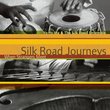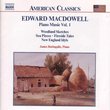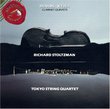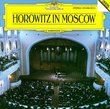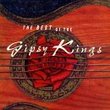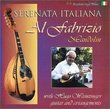| All Artists: George Frederick McKay, John McLaughlin Williams, Ukraine State Radio Symphony Orchestra, Ludmilla Kovaleva Title: McKay: Violin Concerto, 16th Century Hymn Tunes Members Wishing: 0 Total Copies: 0 Label: Naxos American Release Date: 1/18/2005 Genre: Classical Styles: Forms & Genres, Concertos, Historical Periods, Modern, 20th, & 21st Century, Symphonies Number of Discs: 1 SwapaCD Credits: 1 UPC: 636943922521 |
Search - George Frederick McKay, John McLaughlin Williams, Ukraine State Radio Symphony Orchestra :: McKay: Violin Concerto, 16th Century Hymn Tunes
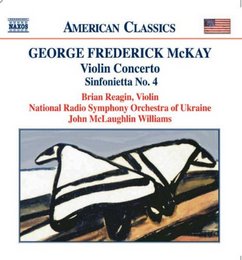 | George Frederick McKay, John McLaughlin Williams, Ukraine State Radio Symphony Orchestra McKay: Violin Concerto, 16th Century Hymn Tunes Genre: Classical
|
Larger Image |
CD DetailsSimilarly Requested CDs
|
CD ReviewsAn Extremely Strong Program of McKay's Extremely Fine Music J Scott Morrison | Middlebury VT, USA | 01/26/2005 (5 out of 5 stars) "This CD is the third in a series devoted to the music of George Frederick McKay (1899-1970) which certainly deserves whatever attention it is currently getting. One hopes that the years of neglect that this composer's music has experienced - largely because for most of his professional life he lived in the Pacific Northwest, far away from US classical music centers - are over. He is remembered with fondness, though, by citizens of Seattle, where his music has continued to be performed occasionally; by alumni of the University of Washington where he taught for many years; and by such students of his as the eminent current-day composer William Bolcom, who indeed was a major participant in the second CD in the series devoted to McKay's chamber music. One only wishes that another of his former students, Goddard Lieberson, who went on to become a huge influence in the classical music recording industry, had done something to preserve his music in recordings, but alas that didn't happen. This CD, the second to present orchestral music of McKay's conducted by John McLaughlin Williams, is a fine addition to the series. It comprises four very different works that, among other things, show the range that McKay had. By far the most important work here is the Violin Concerto (1940) which is here played with real commitment, virtuosic precision and ravishing tone by Brian Reagin, a violinist new to me but one who bears watching. He is currently the concertmaster of the North Carolina Symphony Orchestra and was previously assistant concertmaster of the Pittsburgh Symphony. The Concerto, in three movements in the usual fast-slow-fast arrangement, is played without pause. The first movement is dramatic and declamatory. The first appearance of the violin is a statement of the movement's most important theme in double-stops and gossamer arpeggios. The orchestra features peremptory brass interjections that, an evidence of McKay's expertise, do not ever cover the soloist. There are several cadenzas in this movement, none long but all of them extraordinarily virtuosic. The final cadenza leads into the lyrical second movement which is clearly the heart of the concerto. Harmonically this movement sounds, to this listener, as if it could only have been composed in the 1940s, using as it does chromatic and bluesy harmonies that were newly in the air during that time. Think, if you will, of the harmonies and sinuous melodic contour of David Raksin's theme-song for the movie, 'Laura,' written three years later, and you'll have some idea of this movement's atmosphere; I hasten to add that what McKay does here is miles more effective (and sophisticated) than Raksin's effort. A passage for solo violin and flute leads into the exuberantly rhythmic third movement which begins with woodwind writing that reminded me right away of the similarly orchestrated wind chords in Edward MacDowell's 'Indian Suite.' And indeed both the melodic and rhythmic elements of this movement remind one of authentic Indian music, through the prism of classical techniques, and at the same time the mild jazziness of the earlier movements continues. This is an extraordinarily strong violin concerto and I would venture to say that it is the equal of Samuel Barber's concerto which some think is the finest ever written by an American. This is strong praise, I realize, about which I've thought seriously. I'll go further and say that McKay's third movement is more effective that Barber's. The 'Suite on Sixteenth Century Hymn Tunes' (originally for organ, 1945; rev. 1962) is for strings alone (except for the appropriate addition of the celesta in the fourth movement, 'Choeur céleste'). The strings are divided into two separate orchestras. The five movements are elaborations on hymns by 16th century French composer, Louis Bourgeois, written for John Calvin's Genevan Psalter. The tunes themselves are lovely, and their incorporation into McKay's work extremely effective. I particularly liked the concluding 'Cortège joyeux,' a celebratory recessional. 'Sinfonietta No. 4' (1942), one of five McKay wrote, was, according to the very informative notes by conductor Williams, a precursor to his 'true' symphony, the so-called 'Evocation' Symphony, recorded nicely in the first CD in this series. In three movements, the first is more neo-classic, spare, rhythmically asymmetric, harmonically astringent and bracing than the other works on this CD. The second movement evokes, with its lonely wind solos, the wide-open spaces of the American West without sounding in the least like Copland's brand of 'Western-ness.' Again, there is an American Indian tinge to the melodies. The finale, Allegro gioioso e ritmico molto, is McKay in a playful, even prankish, mood. It burbles along cheerfully, interrupted now and again by brass fanfares and chirruping winds. Yet, it is in modified sonata allegro form, with concentrated development and recapitulation leading to a jubilant coda that ends abruptly with a hiccup. The final work, 'Song Over the Great Plains' (1953), was written on commission from the Indianapolis Symphony who asked for a work to commemorate the 100th anniversary of the founding of the Steinway Piano Company. It has an important piano obbligato part, played here by Ludmilla Kovaleva, but is not quite a piano concerto. It is a fourteen-minute single movement work that evokes early spring in the northern Great Plains - McKay had spent some time teaching in South Dakota before moving to Seattle - and quotes the call of the western meadowlark, happily quite recognizable by this reviewer from Kansas for whom it is the state bird. The work has a main theme that sounds like a folksong, but Williams assures us it is original with McKay. It builds to a climax followed by a long piano cadenza before dying away as softly as it began. A lovely piece worthy of being mentioned in the same breath as Vaughan Williams's own lark piece, 'The Lark Ascending.' One cannot praise too highly conductor John McLaughlin Williams for bringing us the music in this extraordinary program, nor the playing of the National Radio Symphony Orchestra of Ukraine whose growing number of excellent recordings of American music should surely qualify them for honorary US citizenship. Strongest recommendation. Scott Morrison" An Orchestral Vision from Middle 20th-Century America Dr. Debra Jan Bibel | Oakland, CA USA | 09/22/2009 (4 out of 5 stars) "With duration of 78 minutes, this album of McKay's middle period compositions, 1940 to 1962, presents his more vigorously classical works: a concerto, an orchestra suite, and a sinfonietta, plus a encore piece of high merit. As with the previous issue of this particular Naxos series, the National Radio Symphony Orchestra of Ukraine under the baton of John McLauhlin Williams provides the performance. Compared in structure to Bruch's own violin concerto, this piece's first section is dramatic, followed by a slower contemplative movement, and ends with a fast, rhythmic dance. The lyrical phrases of Brian Reagin's violin are sumptious and the duet with a single flute has its charm. The hymns are those of Louis Bourgeois (c. 1510-1561), and McKay originally composed his pieces for organ. In the string version, they are pleasant and well-crafted but I find nothing special. They are slow and meditative and only with the fifth cortege does the suite become alive. The jagged energy that begins the three movement Sinfonietta No. 4 falls away to a middle pastoral of gentle themes and cloudlike moods; the work closes with light-hearted skipping and jumping, a joyful frolic...and did I heard Rocky and Bullwinkle? The final selection is Song Over the Great Plains, an atmospheric or poetic work with piano that speaks of open lands, climatic power, confidence, and endurance. The piano has the final word in a cadenza and fading pianissimo."
|

 Track Listings (12) - Disc #1
Track Listings (12) - Disc #1